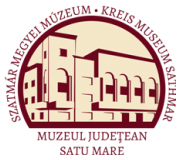Marta, Liviu (szerk.): Satu Mare. Studii şi comunicări. Seria arheologie 26/1. (2010)
Nagy József-Gábor - Körösfői Zsolt: Early Iron Age Storage Pit at Porumbenii Mari-Várfele (Harghita County)
Nagy József-Gábor - Körösfői Zsolt size46. Based on the size differences, it would be meaningless to talk about two different variants, so the researchers gave a different utilitarian function of the smaller vessels as an answer. At the same time, studying the profile of the vessels from Teleac they separated three variants (Ibl-3). It can be pointed out that the Ibl variant from Teleac and the 8Aa variant after Attila László are typologically similar vessels, but smaller with slightly outcurving rim, arched neck and rounded body. A similar vessel found in the pit in Porumbenii Mari bears well smoothed surface, decorated on the neck with horizontal and the upper part of the body with garland channelling (Figure 4/3). The coocurence of these two decorations represents an archaic characteristic;47 there are similar ornament association from the settlements dated back to the Reinecke Br. D - Ha A period from Susani,48 Simeria49 and Igriţa. The above mentioned form and ornament is also present in the early stage of Alba Iulia - Monolit settlement50, recently attributed to the Gáva I phase, dated by Horia Ciugudean in the second half of Ha A period51. Similar finds are know from Teleac as well,52 considered to belong to the earliest phase, Teleac la.53 According to the new chronological sequence proposed by Horia Ciugudean the aforementioned vessel type is not a familiar in the Transylvanian pottery production after the beginning of the Reinecke Ha B period. The smaller pot with well smoothed surface, arched neck and biconical body discovered in the pit in Porumbenii Mari (Figure 4/2) can be classed into the Ib2 variant after Horia Ciugudean,54 into the 3Ba variant after Attila László’s 1994 monograph55 and lb variant after Claudia Pankau’s work56. The “composite shaped vessel”, with widely outcurving rim, cylindrical neck, prominent globular body and conical base57 appears in Valentin Vasiliev’s and his collegues book in 1991 as the II type,58 and at Attila László as the 3A type.59 Claudia Pankau named this type three-piece storied vessel (Dreiteiliges Etagengefaß).60 The medium vessel, with prominent upper body and conical, narrow base from the Porumbenii Mari pit (Figure 3/3) is close to the biconical vessels both regarding the typology and functionality. The characteristic ornament of the belly was the oblique channeling. Typologically similar, but chronologically earlier vessels could be found in the Late Igriţa Group and in the closed finds of the Gáva Culture that can be dated back to the Reinecke Ha A2 - Ha B1 period.61 The carrying on of the mentioned vessels in the Reinecke Ha B period is proved by the findings at Cemat-Hegyes,62 Reci-Telek,63 Turia-Apor kúria,64 Porumbenii Mari-Várfele65 and the second habitation layer at Teleac66. 46 Vasiliev et al. 1991,80. 47 Vasiliev et al. 1991,80-81, 89; Marta 2010, 204. 48 Stratan - Vulpe 1977, pl. 6/94. 49 Andriţoiu 1983, pl. 3/4-5. 50 Ciugudean 2009, taf. VIII/5. 51 Ciugudean 2009, 67-68, abb.2. 52 Vasiliev et al. 1992, 228, fíg. 32/12. 53 Ciugudean 2009, 68, taf. 1/2. 54 Vasiliev et al. 1991,81. 55 László 1994, 77, 302, planşa II/3Ba. 56 Pankau’s 2004, TypenTafel 2/1 b. 57 Foltiny 1967, 63-64, taf. IV-V; László 1973, 591; László 1994, 75. 58 Vasiliev et al. 1992,82. 59 László 1994, 75-77, 302, planşa II/3A. 60 Pankau 2004, 50, Abb. 7/5. 61 V. Szabó 2004, 83. 62 Székely 1966, pl.lV/4,6-7. 63 The characteristic vessel types are: the black coloured, polished vessels with outcurving rim, cylindrical neck, biconical body and narrow base and the composite shaped vessels, with widely outcurving rim, cylindrical neck, prominent globular body and conical base (RepCov 1998, 121, XXVIIIc/10 (455), 269, Pl. XIII/l-2). In the research area there aren’t bosses pushed from inside the vessels which are characteristic for the Gáva I type vessels from the Tisza region (Székely 1962, 327, fig. 2/1; Zaharia 1965, fig. 11/10; Székely 1966, pl. II/3, III/3, IV/1-2; Berciu 1966, planşa XVI; Smirnova 1974, 363, fig. 2, 17, 18; RepCov 1998, 269, pi. XIII/1; Vasiliev 2008, 16, Abb. 1/38-39). 138
